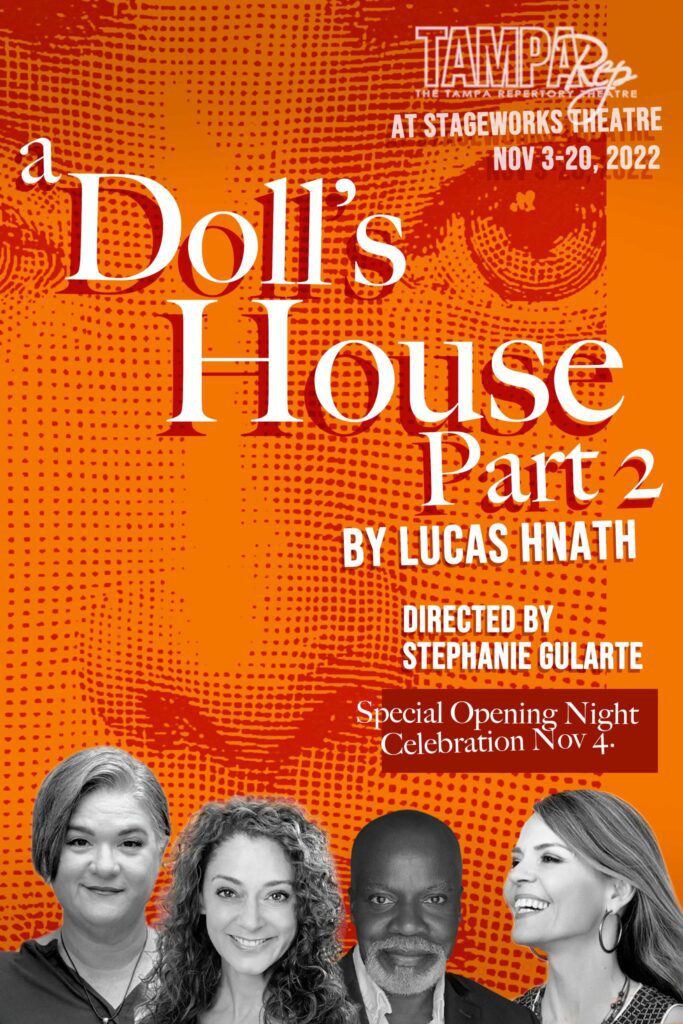TTB: A Doll’s House, Part 2, which premiered in 2017, is playwright Lucas Hnath’s idea of a sequel to Henrik Ibsen’s A Doll’s House, initially produced in 1879. The story in A Doll’s House, Part 2, takes place 15 years after the ending of Ibsen’s A Doll’s House. And there are nearly 140 years between the first production of Ibsen’s play and Hnath’s play. Would you share your thoughts on the differences between the two plays?
ES: The most obvious difference between the plays can be found in the dialogue. Hnath has written these characters to speak in a decidedly contemporary style which makes the characters and the situations particularly relatable to a modern audience. Beyond that, I think ADHP2 is written with more intentional moments of humor than Ibsen’s work. That said, each play delivers a psychologically complex examination of human relationships, in general, and of marriage, in particular.
TTB: Henrik Ibsen’s A Doll’s House was groundbreaking and controversial when it originally premiered. It was polarizing. It caused such vitriol reactions, and it was banned in some countries. Ibsen himself was forced to write an alternate ending for German audiences. With Ibsen’s play having such a powerful impact on society in the 19th Century, how does Hnath’s story match the power of impact for the 21 Century audience? Or do you think it needs to be impactful? What’s the power in Hnath’s play?
ES: I think our reactions to Nora’s choices are not entirely different today than they were in 1879. What has changed is the fact that the function of theatre as a forum for challenging widely-held ideas and values rather than merely validating them is more accepted. So ADHP2 packs a different type of punch than its forerunner. The power of Hnath’s play is its success in compelling us to recognize how much has not changed over the past 150 years and in revealing new layers of complexity in the dynamics of gender-relations, freedom, intimacy, and marriage.
TTB: Does the audience need to be familiar with Ibsen’s A Doll House to follow or be engaged with Hnath’s A Doll’s House, Part 2?
ES: ADHP2 stands on its own as a fulfilling piece of theatre regardless of the audience’s familiarity with Ibsen’s play. But I do think that the newer work is all the more interesting when you know the original story.
TTB: What are the challenges you have discovered in the rehearsal process?
ES: Making sure that we are not judging the characters and their choices in our depiction is essential so that we are not oversimplifying the story by creating heroes and villains. This can be tricky, especially since most of us have such strong, visceral feelings about motherhood and about family. So trying to ensure that we are allowing each character to be flawed while at the same time being utterly relatable in their needs, desires, and fears, is an exciting challenge that we attempt to tackle at each rehearsal.
TTB: Have you made any enlightened discoveries about the story in working on this play? About yourselves? How has this process affected you?
ES: In rehearsals we were talking about the desire to love and to be loved as a central human driver in life throughout time, and about the underlying fear that if we are fully ourselves in our relationships, we may not be loved. While this was not a new observation, the tragedy of it really struck me: The idea that we all want to be loved and yet we struggle to trust that we are truly lovable for who we are. It has made me wonder – if we were able to recognize this in each other, might we more easily find greater compassion for one another, even when we differ in our views and choices?
TTB: What are your hopes for what the audience will take away from experiencing TampRep’s production of A Doll’s House, Part 2?
ES: I hope that audiences will find themselves empathizing with each of the four character’s perspectives at some point in the performance and that they will leave the theatre wanting to discuss the characters’ perspectives and their own reactions to them with one another. To me, that is what theatre at its best offers, an opportunity to deepen our understanding of ourselves and of one another so that we may grow as individuals and strengthen our sense of connection to each other.
TTB: There is always the need for strong ticket sales and greater audience awareness of any theatre production. Yet the past couple of years, the effects of the pandemic have been nearly devastating for many professional theatre companies. Both of you have a history of being strong leaders of theatre companies. What are your thoughts on what theatre companies need from people in the community themselves to strengthen the financial health and longevity of theatre companies?
ES: It’s simple, really: Come to the theatre. Connect to the power of live performance and share it with the people you care about. Keep the art form alive by recognizing the intrinsic value of being in a shared space with other members of the community experiencing live stories that reflect ourselves and our world back to us in ways that make us laugh, cry, and grow.

